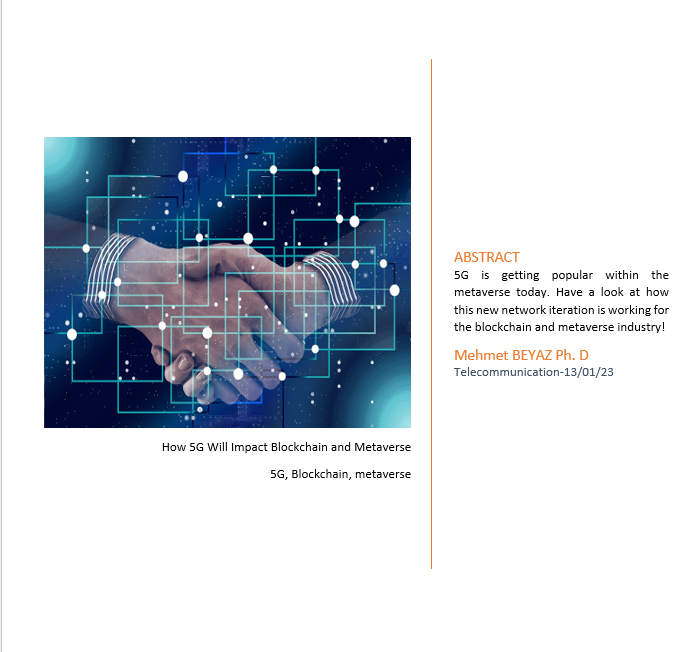
5G is the newest telecom technology expected to transform many industries. A revolutionary era where the material is no longer accessed via 2D screens but instead intuitive 3D settings appear to have begun as a result of strong 5G networks, innovative extended reality (XR) gadgets, and Metaverse applications.
While higher data speeds were the focus of earlier cellular technology generations, 5G promises to change the user experience fundamentally. According to experts, 5G can pave the way for the widespread use of blockchain technology across various industries, including transportation, trade financing, training, healthcare, and more.
The adoption of Web 3.0 technologies will advance significantly with the help of 5G. Today, many businesses are implementing Web 3.0 technology, particularly the Metaverse. The incorporation of blockchain-related technology will be made easier and will both boost and enhance commerce thanks to 5G’s underlying faster speed and improved energy management.
Let’s have a look at how blockchain and the Metaverse will change in the future as 5G becomes more prevalent.
The Impact of 5G on the Blockchain Technology
One of the most widely used technologies nowadays is blockchain. It is used in various fields, including NFTs, cryptocurrency, the Metaverse, and others. In essence, it saves many kinds of transactional data that users carry out.
All transactions occurring in real time can be recorded on a blockchain. Blockchain technology requires an extremely high-speed internet connection to function properly as transactions happen in real time. This internet comes primarily from the 5G network.
Blockchain and 5G work hand in hand. Blockchain guarantees data security and dependability, allowing better and faster value functions. With decreased dormancy, crisp device connectivity, and affordable costs, 5G might give users super-fast speed and better clarity.
Moreover, blockchain will be essential in preserving user confidentiality and safety across the telecom sector, and 5G will help countries embrace and deploy blockchain technology more quickly in return. 5G connections may be validated and protected from identity theft and abuse using blockchain technology. Integrating these technologies will also encourage growth in the application development industry as download and transfer speeds increase, and blockchain makes data management more accessible.
Internet of Things (IoT) devices can be used broadly because of the strength of 5G coverage, which has extremely low latency, fast speeds, and enormous capacity. This would indicate that sensor-driven industrial advancements such as driverless cars, smart cities, smart homes, and other commercial use cases will ultimately have a technology that can meet their requirements.
IoT devices have powerful chips and sensors, allowing for seamless internet communication and information exchange. As the goal of 5G is to minimize network bandwidth and enable live interaction between devices, it offers great potential for IoT devices.
Widespread adoption of existing IoT models is difficult since they are centralized, which indicates that one company owns them. Blockchain offers decentralization, which implies that no one really controls how these devices run. Every data transmission is documented in a distributed ledger, allowing consumers complete control over their security. On 4G, this would not be feasible.
Tracking shipments is another fascinating application for blockchain technology and 5G. Customers desire information about order shipment and tracking. It can be difficult to trace the whereabouts of goods if it is ordered from another country. However, customers and businesses will soon be able to track the precise location in real-time thanks to 5G and blockchain technologies.
The impact of 5G Technology on NFTs and Crypto
According to statistics from Dune Analytics, the NFT market crashed from its record of $17 billion in the initial months of 2022 to $470 million in September 2022, indicating a staggering 97 percent collapse.
The NFT business now has some reason to believe that it will thrive thanks to 5G. Although there may not be a direct correlation, 5G is anticipated to improve connectivity and reduce network traffic problems, particularly for blockchain and Web 3.0 gaming.
By including 5G in the accessibility equation, it will be possible to determine whether the network can handle a demanding game utilizing NFTs.
Blockchain-based apps that demand real-time data transmissions, such as Defi platforms, cryptocurrency exchanges, and payment systems, will prosper thanks to the 5G upgrade. Although many crypto wallets are on the market right now, they are not well-known.
This presents a massive opportunity in terms of increasing operation and usefulness. The wallets with tactile user experiences function as a doorway to an uncharted digital universe. The foundation for realizing this objective is 5G.
Low latency 5G will make it possible for the crypto wallet’s UX to perform flawlessly while complicated operations happen in the background. 5G can do a lot to hide the user from the intricacy of crypto. Cryptocurrency wallets can be thought of as mobile wallets that are connected to the internet, along with the exciting worlds of broadcasting and gaming. The growth of capacity and support for lower power consumption is made possible with 5G.
Since 5G is ready to deliver quick, byte-sized mobile phone interactions, it will attract more crypto users since this is exactly what the younger generation demands.
The Impact of 5G on the Metaverse
The Metaverse technology can make a distinct virtual world seem identical to the real one. In this universe, it is simple to carry out all the tasks that one would normally do in the actual world.
It all comes down to reproducing a vast, immersive environment with high speed, thousands of avatars, real-time interactions, and communication, as well as an additional layer of XR, which necessitates several renderings. This demands a robust, fast internet, which 5G provides.
In general, telecommunications and 5G have advanced significantly. A thriving ecosystem of suppliers, service providers, equipment OEMs, cloud hyperscalers, and app developers has grown out of what was once only about connectivity over time. This is due to the sophistication and exhilaration that wireless technology brings.
Many wireless communication technologies are available today, with Wi-Fi, Bluetooth, and cellular technologies being among the most well-liked ones in terms of ubiquitous availability. However, they all have their drawbacks.
Bluetooth, for instance, has poor reliability, speed, and range. Moreover, when many XR devices are connected at once, current generations of Wi-Fi provide the necessary rate but have traffic and significant latencies.
Although Wi-Fi 7 claims to solve the congestion problem, it falls well short of cellular technology in terms of range and worldwide coverage. Additionally, it doesn’t include any Service Level Agreements, which are essential for many business apps and can be offered using new 5G slicing principles.
5G delivers rate, distance, dependability, latency, and much more for the Metaverse. Each customer currently receives an average of 200Mbps of data through 5G. The fastest internet speed will undoubtedly be provided by 5G, allowing all Metaverse users to conduct high-quality activities. The introduction of 5G connectivity has increased the real-time Metaverse operational speed.
Automation development depends on 5G because it provides a highly connected and digital environment where robots, vehicles, and gadgets may work independently with minimal human intervention.
Furthermore, 5G—an essential enabler for the Metaverse—makes Web 3.0 conceivable. The Metaverse offers individuals and organizations of all sizes a variety of options to purchase, sell, and trade products and services, hence supporting the establishment of significant economic segments. It combines VR and AR with cutting-edge technology like blockchains, AI, and 5G.
Due to 5G and extended reality, people will be able to access their favorite Metaverse at any time, and they will also benefit from creative apps and services. Furthermore, 5G networks will bring computer power closer to the customer to reduce latency. Presently, users open the internet by starting a browser tab or an application.
The network edge will support the deployment of extra network resources, allowing for a greater connection and capacity for Metaverse applications. Lastly, due to the underlying 5G technologies, use cases for the consumer and corporate Metaverse will emerge. For instance, a business may be organized so every worker can engage with coworkers in a fully immersive environment.
One to two hours every week are now spent utilizing Augmented Reality apps by subscribers, thanks to 5G. According to data from Ericsson, 5G customers spend an hour more each week on average using services related to the Metaverse than 4G users.
According To Ericsson, by 2025, customers expect to watch an additional two hours of video material on mobile devices with 5G capabilities. Moreover, according to 50% of 5G users who already utilize XR-related applications weekly, AR apps will migrate from smartphones to XR headsets in the coming two years.
Final Thoughts
Despite the numerous obstacles that must be overcome, there are a lot of chances for society to adopt a new way of using the internet as we currently know it. Potentially, 5G could make it possible to recreate various physical situations in real-time. Due to this, IT companies are extensively adding 5G to their services.
When 5G is integrated into current 4G network infrastructures, more features, and positive user experiences will be feasible. We already see the influence of 5G in industries, including financial services, retail, production, medical, media, and entertainment.


